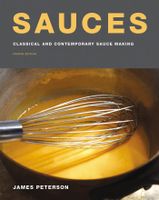Hydrocolloids
Published 1991
Perhaps the most important family of these new (and not so new) thickeners consists of hydrocolloids. Technically, a hydrocolloid is anything that disperses particles in water. Even though some hydrocolloids are starches or very similar to starches, when chefs refer to hydrocolloids, they’re talking about substances that form long chains of polymers (usually of simple sugars, but sometimes amino acids). These polymers interfere with the fluidity of water and render a sauce thicker. Many hydrocolloids also act as emulsifiers and hence thicken—or at least keep from breaking—sauces such as hollandaise or mayonnaise. Hydrocolloids can also cause liquids to gel, a useful characteristic when making chauds-froids and gelées. For a list of hydrocolloids.
Become a Premium Member to access this page
Unlimited, ad-free access to hundreds of the world’s best cookbooks
Over 160,000 recipes with thousands more added every month
Recommended by leading chefs and food writers
Powerful search filters to match your tastes
Create collections and add reviews or private notes to any recipe
Swipe to browse each cookbook from cover-to-cover
Manage your subscription via the My Membership page
Monthly plan
Annual plan
Part of
Advertisement
Advertisement


